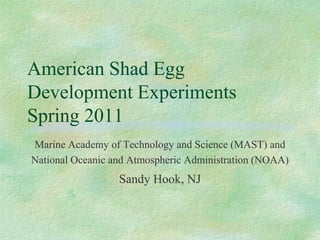
American Shad Egg Development during Shad in Classroom
- 1. American Shad Egg Development Experiments Spring 2011 Marine Academy of Technology and Science (MAST) and National Oceanic and Atmospheric Administration (NOAA) Sandy Hook, NJ
- 2. Senior Research Projects 2011 - 2012 Sunday Mother’s Day May 2012 - Eggs harvested and fertilized by Jim Cummins of the ICPRB from Potomac River - approximately 8 PM Eggs transported from VA to NJ early Monday morning Three Hatching Systems set up - one control, two studies Catherine S. studied the effect of suspended solids Ryan C. studied the effect of reduced surface area for biological growth Third system set up to run at optimal conditions for hatching
- 3. Day One Sort Eggs - 12 hours Development Picture credit - Kathleen Devine Picture credit - NOAA/NEFSC/Howard Laboratory 2011 -Blastodisc formed on egg yolk Petri Dish Full of viable eggs -Two eggs dead, one dying, seven developing
- 4. Day One Sort Eggs - 12 hours Development Pictures credit - NOAA/NEFSC/Howard Laboratory 2011 Close ups of two different eggs - formation of “backbone/spinal column” - vertebrae
- 5. Day Two Eggs - 36 hours Development Pictures credit - NOAA/NEFSC/Howard Laboratory 2011 Backbone clearly visible with tail bud and myomeres visible
- 6. Day Three Eggs - 60 hours Development Pictures credit - NOAA/NEFSC/Howard Laboratory 2011 Tail free embryo, eyes developing, more myomeres
- 7. Day Four Eggs - 84 hours Development Pictures credit - NOAA/NEFSC/Howard Laboratory 2011 Yolk covered with stellate Some Hatched chromatophores, heart visible
- 8. Day Five Eggs - 84 hours Development Pictures credit - NOAA/NEFSC/Howard Laboratory 2011 Hatched with eyes, heart behind eyes, yolk sac, fins visible 12x, 25X
- 9. Conclusions The students observed American Shad egg development. Catherine was able to conclude that suspended solids is not conducive to egg development due to mortality. Ryan could not statistically prove the effect of reduced surface area on development.
- 10. Line Drawings of Egg Development - 1978 Development of Fishes of Mid-Atlantic Bight; An Atlas of Egg, Laval, and Developmental Stages - Fish and Wildlife Services 1978 Volume 1 page 100
- 11. Recommendations Hope for eggs from the Natural Spawning Tank project on the Delaware Test the effect of light exposure Test the difference on the source of eggs - Potomac to Delaware Develop a Shad egg apgar test Continue to share information with other programs
- 12. Acknowledgements (This project could not have happened without) The cooperation from Northeast Fisheries Science Center, James Howard Laboratory on Sandy Hook for use of their staff, scope, camera, and software under the direction of Dr. Chris Chambers. The contribution of fertilized eggs from Jim Cummins of the Interstate Commission on the Potomac River Basin. The shad fisherman who took Jim and Kathleen out on the Chesapeake. The sound teaching of Barbara Boyd of MAST. The facilitation of Carl Alderson of NOAA Restoration Center - Sandy Hook Office Claire Steimle of NOAA - James Howard Library The inspiration of Delaware Shad Fishermen Association. The book: Let the Rivers Run Silver Again by Sandy Burke. The technical support from NJDEP, USFW, PFBC, and DRBC. This support came from Russ Allen, Mark Boriek, Jerre Mohler, Michael Hendricks, Michael Odom. The local fisherman of the Jersey Shore with the cooperation of Fletcher Chayes. The labor of Brian Harris who built the hatching systems. The family and friends of Kathleen Devine, who drive her to VA and listen to her talk about the American Shad.
- 13. References: Catherine Sufficool - AMERICAN SHAD EGG AND JUVENILE OBSERVATION OF AVERAGE GROWTH IN THE JAMES J. HOWARD LABORATORY - 27 FEBRUARY 2012 Ryan Corbett - AMERICAN EGG AND JUVENILE OBSERVATION FEBRUARY 2012 Development of Fishes of Mid-Atlantic Bight; An Atlas of Egg, Laval, and Developmental Stages - Fish and Wildlife Services 1978 Volume 1 page 100- 101
- 14. Thank you!
- 15. Contact: For questions regarding this Power Point Presentation contact Kathleen Devine Email: kdevine5@gmail.com Phone: 732-229-5849 Please credit the appropriately credit pictures to NOAA/NEFSC/Howard Laboratory 2011